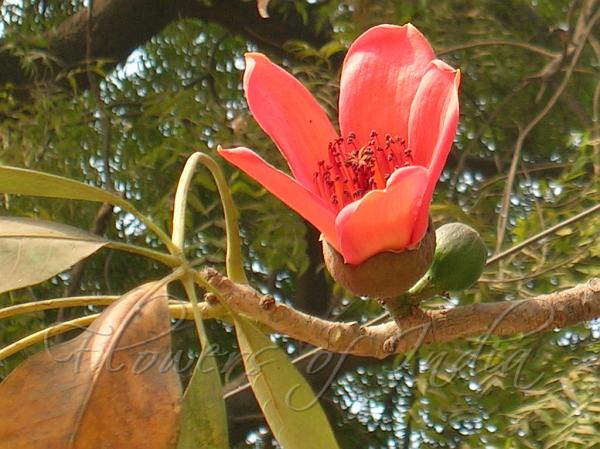|
| Silk Cotton Tree |
|

|

| File size | 158477 |
| Original date | 2/12/06 1:59 PM |
| Resolution | 2048 x 1536 |
| Flash | Flash did not fire, auto |
| Focal length | 16.2mm |
| Exposure time | 1/110s |
| Aperture | 4.9 |
| Focus Distance | |
| Metering Mode | Partial |
| Camera make | NIKON |
| Camera model | E3700 |
| Sensor type |
|
|
|
Photo: |
Botanical name: Bombax ceiba Family: Malvaceae (Mallow family)
Synonyms: Salmalia malabarica
Synonyms: Salmalia malabarica
Silk cotton tree is a type of native cotton tree with large red flowers.
The genus name Salmalia is derived from the sanskrit name
shaalmali.
Silk cotton trees comprise eight species in the genus Bombax, native to India,
tropical southern Asia, northern Australia and tropical Africa.
Semul trees bear beautiful red-colored flowers during January to March. The
phenomenon paints the whole landscape in an enchanting red hue. The fruit, the
size of a ping-pong ball, on maturity appears during March and April. These
are full of cotton-like fibrous stuff. It is for the fiber that villagers
gather the semul fruit and extract the cotton substance called "kopak". This
substance is used for filling economically priced pillows, quilts, sofas etc.
The fruit is cooked and eaten and also pickled.
Semul is quite a fast growing tree and can attain a girth of 2 to 3 m, and
height about 30 m, in nearly 50 years or so. Its wood, when sawn fresh, is
white in color. However, with exposure and passage of time it grows darkish
gray. It is as light as 10 to 12 kg, per cubic foot. It is easy to work but
not durable anywhere other than under water. So it is popular for construction
work, but is very good and prized for manufacture of plywood, match boxes and
sticks, scabbards, patterns, moulds, etc. Also for making canoes and light
duty boats and or other structures required under water.
Bombax species are used as food plants by the larvae of some Lepidoptera
species including the leaf-miner Bucculatrix crateracma which feeds
exclusively on Bombax ceiba.
| Identification credit: Tabish | Photographed in Delhi & Goa. |
• Is this flower misidentified? If yes,